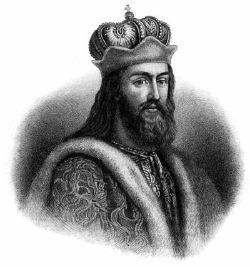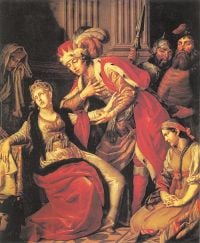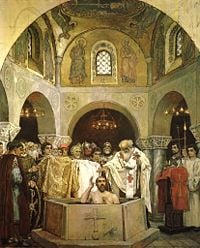Difference between revisions of "Vladimir I of Kiev" - New World Encyclopedia
m (→Baptism of Rus) |
|||
| Line 40: | Line 40: | ||
Though [[Christianity]] had won many converts since Olga's rule, Vladimir had remained a pagan. He reportedly took 800 concubines, besides numerous wives and erecting statues and shrines to various gods. However, some sources claim that he attempted to reform Slavic [[paganism]] by establishing thunder-god [[Perun]] as a supreme deity. | Though [[Christianity]] had won many converts since Olga's rule, Vladimir had remained a pagan. He reportedly took 800 concubines, besides numerous wives and erecting statues and shrines to various gods. However, some sources claim that he attempted to reform Slavic [[paganism]] by establishing thunder-god [[Perun]] as a supreme deity. | ||
| − | ==Baptism of Rus== | + | ==Baptism of the Rus'== |
| − | + | ===Valdimir's conversion=== | |
[[Image:Vasnetsov Bapt Vladimir.jpg|thumb|200px|The Baptism of Saint Prince Vladimir, by [[Viktor Vasnetsov]] (1890)]] | [[Image:Vasnetsov Bapt Vladimir.jpg|thumb|200px|The Baptism of Saint Prince Vladimir, by [[Viktor Vasnetsov]] (1890)]] | ||
| − | + | Russian [[Primary Chronicle]], a history of the Kievan Rus from around 850 to 1110, reports that in the year 987, Vladimir sent envoys to study the religions of the various neighboring nations whose representatives had been urging him to embrace their respective faiths. The result was amusingly described by the [[Nestor the Chronicler|chronicler Nestor]]. Of the [[Muslim]] Bulgarians of the [[Volga]] the envoys reported there was no gladness among them, "only sorrow and a great stench," and that their religion was undesirable due to its [[taboo]] against [[alcoholic beverage]]s and [[pork]]. Vladimir reportedly commented, on hearing their report: "Drinking is the joy of the Rus'." | |
| − | + | Russian sources also describe Vladimir as consulting with [[Jewish]] envoys, who may or may not have been [[Khazars]], and questioning them about their religion but ultimately rejecting it, because their loss of [[Jerusalem]] was evidence of their having been abandoned by [[God]]. Ultimately Vladimir settled on [[Christianity]]. However in the Catholic churches of the Germans his emissaries saw no beauty. On the other hand, at [[Constantinople]], the ritual and beautiful architecture of the [[Orthodox Church]] deeply impressed them. "We no longer knew whether we were in heaven or on earth," they reported, describing a majestic liturgy in [[Hagia Sophia]]. The splendor of the church itself was such that "we know not how to tell of it." | |
| − | + | Vladimir was no doubt duly impressed by this account of his envoys, but may have been even more keenly aware of the political gains he would receive from the Byzantine alliance. | |
| + | |||
| + | In 988, having taken the town of [[Chersonesos]] in [[Crimea]], he boldly negotiated for the hand of the emperor [[Basil II]]'s sister, Anna. Never had a Greek imperial princess married a "barbarian" before, as matrimonial offers of French kings and German emperors had been peremptorily rejected, and these, at least, were Christians. Indeed, to marry the 27-year-old princess off to a pagan Slav seemed impossible. | ||
| + | |||
| + | Vladimir was therefore baptized at Cherson, taking the Christian name of Basil out of compliment to his soon-to-be imperial brother-in-law. This sacrament was followed by his wedding with Anna. Returning to Kiev in triumph, he destroyed pagan monuments and established many churches, starting with the splendid [[Church of the Tithes]] (989) and monasteries on [[Mount Athos|Mt. Athos]]. | ||
| + | |||
| + | ===Alternate account=== | ||
| + | |||
| + | [[Arab]] sources, both Muslim and Christian, present a different story of Vladimir's conversion. In this version, [[Bardas Sclerus]] and [[Bardas Phocas]] revolted against the Byzantine emperor [[Basil II]] in 987. Both rebels briefly joined forces, and Bardas Phocas proclaimed himself emperor on September 14, 987. | ||
| + | |||
| + | Basil II turned to the Rus' for assistance, even though they were considered enemies at that time. Vladimir agreed, but his price was the hand of the princess Anna. He also agreed to accept Orthodox Christianity as his religion and bring his people to the new faith. When the wedding arrangements were settled, Vladimir dispatched 6,000 troops to the Byzantine Empire and they helped to put down the revolt. | ||
==Christian reign== | ==Christian reign== | ||
Revision as of 01:20, 12 August 2008
| Saint Vladimir of Kiev | |
|---|---|
Vladimir I of Kiev, as illustrated in the 1905 The Story of Russia, by R. Van Bergen | |
| Grand Prince of Kiev | |
| Born | c. 950 |
| Died | 1015 |
| Feast | July 15 |
| Attributes | crown, cross, throne |
Saint Vladimir Svyatoslavich the Great (c. 958 – 15 July 1015, Berestovo) was the grand prince of Kiev who converted to Christianity in 988, and proceeded to baptise the whole Kievan Rus. His name may be spelled in different ways: in Old East Slavic as Volodimir (Володимир), in modern Ukrainian as Volodymyr (Володимир), in Old Church Slavonic and modern Russian as Vladimir (Владимир), in Old Norse as Valdamarr and the modern Scandinavian languages as Valdemar.
Way to the throne
Vladimir was the youngest son of Sviatoslav I of Kiev by his housekeeper Malusha, described in the Norse sagas as a prophetess who lived to the age of 100 and was brought from her cave to the palace to predict the future. Malusha's brother Dobrynya was Vladimir's tutor and most trusted adviser. Hagiographic tradition also connects his childhood with the name of his grandmother, Olga Prekrasa, who was a Christian and governed the capital during Sviatoslav's frequent military campaigns.
Transferring his capital to Preslavets in 969, Sviatoslav designated Vladimir as ruler of Veliky Novgorod, but gave Kiev to his legitimate son Yaropolk. After Sviatoslav's death in 972, a fratricidal war erupted between Yaropolk and his younger brother Oleg, ruler of the Drevlians in 976. As a result of the fighting Vladimir was forced to flee from Novgorod. He went to his kinsmen, Haakon Sigurdsson, the ruler of Norway in 977, and gathered as many of the Viking warriors as he could to assist him to recover Novgorod, and on his return the next year marched against Yaropolk.
On his way to Kiev Vladimir sent ambassadors to Rogvolod (Norse: Ragnvald), prince of Polotsk, to sue for the hand of his daughter Rogneda (Norse: Ragnhild). The noble princess refused to engage herself to the son of a bondswoman. However, when Vladimir attacked Polotsk and slew Rogvolod, Ragnhild was left with no choice.
Polotsk was also a key fortress on the way to Kiev, and the capture of this city together with Smolensk facilitated Vladimir's taking of Kiev in 980, where he slew Yaropolk and was proclaimed konung (king) of all Kievan Rus.
In addition to gaining control of his father's extensive domain, Vladimir continued to expand his territories subtantially. In 981 he conquered the central European Cherven cities, in modern Galicia. In 983 he subdued the Yatvingians, whose territories lay between Lithuania and Poland. In 985 he led a fleet along the central rivers of Russia to conquer the Bulgars of the Kama, planting numerous fortresses and colonies on his way.
Though Christianity had won many converts since Olga's rule, Vladimir had remained a pagan. He reportedly took 800 concubines, besides numerous wives and erecting statues and shrines to various gods. However, some sources claim that he attempted to reform Slavic paganism by establishing thunder-god Perun as a supreme deity.
Baptism of the Rus'
Valdimir's conversion
Russian Primary Chronicle, a history of the Kievan Rus from around 850 to 1110, reports that in the year 987, Vladimir sent envoys to study the religions of the various neighboring nations whose representatives had been urging him to embrace their respective faiths. The result was amusingly described by the chronicler Nestor. Of the Muslim Bulgarians of the Volga the envoys reported there was no gladness among them, "only sorrow and a great stench," and that their religion was undesirable due to its taboo against alcoholic beverages and pork. Vladimir reportedly commented, on hearing their report: "Drinking is the joy of the Rus'."
Russian sources also describe Vladimir as consulting with Jewish envoys, who may or may not have been Khazars, and questioning them about their religion but ultimately rejecting it, because their loss of Jerusalem was evidence of their having been abandoned by God. Ultimately Vladimir settled on Christianity. However in the Catholic churches of the Germans his emissaries saw no beauty. On the other hand, at Constantinople, the ritual and beautiful architecture of the Orthodox Church deeply impressed them. "We no longer knew whether we were in heaven or on earth," they reported, describing a majestic liturgy in Hagia Sophia. The splendor of the church itself was such that "we know not how to tell of it."
Vladimir was no doubt duly impressed by this account of his envoys, but may have been even more keenly aware of the political gains he would receive from the Byzantine alliance.
In 988, having taken the town of Chersonesos in Crimea, he boldly negotiated for the hand of the emperor Basil II's sister, Anna. Never had a Greek imperial princess married a "barbarian" before, as matrimonial offers of French kings and German emperors had been peremptorily rejected, and these, at least, were Christians. Indeed, to marry the 27-year-old princess off to a pagan Slav seemed impossible.
Vladimir was therefore baptized at Cherson, taking the Christian name of Basil out of compliment to his soon-to-be imperial brother-in-law. This sacrament was followed by his wedding with Anna. Returning to Kiev in triumph, he destroyed pagan monuments and established many churches, starting with the splendid Church of the Tithes (989) and monasteries on Mt. Athos.
Alternate account
Arab sources, both Muslim and Christian, present a different story of Vladimir's conversion. In this version, Bardas Sclerus and Bardas Phocas revolted against the Byzantine emperor Basil II in 987. Both rebels briefly joined forces, and Bardas Phocas proclaimed himself emperor on September 14, 987.
Basil II turned to the Rus' for assistance, even though they were considered enemies at that time. Vladimir agreed, but his price was the hand of the princess Anna. He also agreed to accept Orthodox Christianity as his religion and bring his people to the new faith. When the wedding arrangements were settled, Vladimir dispatched 6,000 troops to the Byzantine Empire and they helped to put down the revolt.
Christian reign
He now formed a great council out of his boyars, and set his twelve sons over his subject principalities. With his neighbors he lived at peace, the incursions of the Pechenegs alone disturbing his tranquillity. After Anna's death, he married again, most likely to a granddaughter of Otto the Great.
He died at Berestovo, near Kiev, while on his way to chastise the insolence of his son, Prince Yaroslav of Novgorod. The various parts of his dismembered body were distributed among his numerous sacred foundations and were venerated as relics. One of the largest Kievan cathedrals is dedicated to him. The University of Kiev was named after the man who both civilized and Christianized Kievan Rus. There is the Order of St. Vladimir in Russia and Saint Vladimir's Orthodox Theological Seminary in the United States. The Roman Catholic and Eastern Orthodox churches celebrate the feast day of St. Vladimir on 15 July.
His memory was also kept alive by innumerable Russian folk ballads and legends, which refer to him as Krasno Solnyshko, that is, the Fair Sun. With him the Varangian period of Eastern Slavic history ceases and the Christian period begins.
Notes
ReferencesISBN links support NWE through referral fees
- Marullo, Thomas G. Ivan Bunin: The Twilight of Emigre Russia, 1934-1953: A Portrait from Letters, Diaries, and Memoirs. Ivan R. Dee, Publisher (August 25, 2002). ISBN 978-1566634335.
- Lives of Eminent Russian Prelates: I. Nikon, Sixth Patriarch of Moscow. II. Saint Demetrius, Metropolitan of Rostoff. III. Michael, Metropolitan of Novgorod and S. Petersburg. Adamant Media Corporation (July 10, 2001). ISBN 978-1402168840.
- Starr, Brian D. Major Saints Ancestry. BookSurge Publishing (July 20, 2007). ISBN 978-1419665271.
External Links
- Golden, P.B. (2006) "Rus." Encyclopaedia of Islam (Brill Online). Eds.: P. Bearman, Th. Bianquis, C.E. Bosworth, E. van Donzel and W.P. Heinrichs. Brill.
- This article incorporates text from the Encyclopædia Britannica Eleventh Edition, a publication now in the public domain.
Credits
New World Encyclopedia writers and editors rewrote and completed the Wikipedia article in accordance with New World Encyclopedia standards. This article abides by terms of the Creative Commons CC-by-sa 3.0 License (CC-by-sa), which may be used and disseminated with proper attribution. Credit is due under the terms of this license that can reference both the New World Encyclopedia contributors and the selfless volunteer contributors of the Wikimedia Foundation. To cite this article click here for a list of acceptable citing formats.The history of earlier contributions by wikipedians is accessible to researchers here:
The history of this article since it was imported to New World Encyclopedia:
Note: Some restrictions may apply to use of individual images which are separately licensed.



